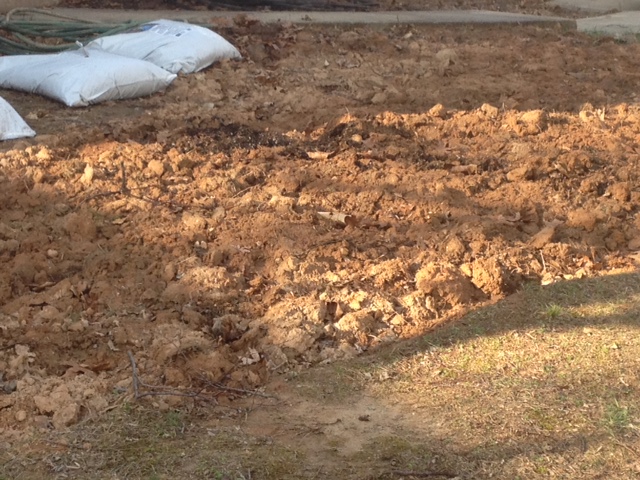Choosing

To think that getting started was my original problem with work. Now I can't figure out where to stop.
Photo of the author's garden, if you want to call it that.
My first, earliest problems as a writer were just producing draft at all. About 10 years in--no, I'm not kidding--I had enough material and a head of steam gathered, but then I had a bigger problem: revising.
The longer I have lived and worked, the more I have realized that the heart of creativity is not really making but choosing what to make, and how to make it. Paradoxically, there seems no better way to choose than by introducing chance, randomness, looseness, and willingness into your process.
That's why it takes so long. That's why it's so frustrating. That's why we hate it when we don't love it and love it when we don't hate it. Making meaningful work of any kind--not just art, but also our very lives and livelihoods--demands the most disciplined and consistent lack of control imaginable.
There are tricks. Here are some of mine.
As you should do daily, go through the warm-up exercises first described Lesson 8, "Walking in Two Simple Steps."
Then, try at least one of these tactics today, to assemble a full first draft or to begin revising something into a second draft.
Choosing Exercise 1: Recognize the "Down Draft" versus the "Up Draft"
In her best-known essay on writing, "Shitty First Drafts," Anne Lamott describes this advice: "A friend of
mine says that the first draft is the down draft -- you just get it down. The second
draft is the up draft -- you fix it up. You try to say what you have to say more
accurately. And the third draft is the dental draft, where you check every tooth, to
see if it's loose or cramped or decayed, or even, God help us, healthy."
We're not suggesting you ever act like a dentist unless you are one, but that advice about how to see your work has helped me loosen up when I am drafting and settle down without tightening when I start to revise. It's a rule of thumb more than a real trick (see Exercise 2), but sometimes just seeing where you are is the biggest step toward pulling together your work.
Choosing Exercise 2: Say You're Done and You Will Be
When I was writing my first book, I came to a realization: no one but me could decide when the first draft was really done. So I tricked myself. When I had collected about 300 pages--some of them re-typed notes and fragments, I numbered them and put them in a folder and called them Draft #1. Printed it out, too. How's that for commitment?
Try this with something you have been working on this week. Assemble the motley notes and pages, type them neatly without judgment, print them out, and admire your work. There is something about seeing 10 or 20 or 100 finished-looking pages that can encourage you.
Choosing Exercise #3: The Collage
Peter Elbow is among the proponents of a technique that goes by many names. He calls it collage:
"Collage uses the simplest but most effective aesthetic principle: put things together if they sort of go. They need to “go” . . . but not too well. Interest and pleasure increase if there is some friction, resistance, difference. A bouquet is a collage, but a good bouquet needs some clash."

Some things I put together in my garden. "Divine Beings." Photo by author.
Without the collage technique, I probably would have stopped writing decades ago. It is an especially good form for a busy, overcommitted person. It is handy for virtually every stage of writing until the very last. It can also be used not for writing a finished piece, but for considering and juxtaposing complex experiences, simply for yourself.
If you are drafting right now, collaging can be used to organize and assemble your different days' work, to match up writing that was not done on the same topic but seems related, or to mix research with your writing to see how it feels.
If you are revising, collaging can be used to knock you out of a stuck place and see your draft as soft and malleable, so you can shake up and rediscover your points. I have actually been known to cut apart and reassemble a draft if I felt too tight and afraid to revise it.
If you are just seeking ideas or handling emotionally or intellectually difficult, inaccessible material, the collage is a marvelous way to play and loosen up without committing to your topic or approach yet. You can keep one percent of your findings and throw away the rest; even that will be something you would have found no other way.
Here are Peter Elbow's instructions for making a written collage (more from Elbow here).
- Do or gather as much of your writing on your topic as you can. Go fast, don’t worry. Freewriting is a good idea. Take thoughts in any order that they come.
- Go through what you have and choose best and potentially best bits--freely cutting to find long and short sections.
- Revise what you have, but only by cutting, not rewriting. Cut paragraphs and sentences; cut phrases and words. Of course you can cheat by doing some rewriting, but it’s amazing what is possible by just cutting.
- Figure out a pleasing order for the bits: perhaps logical, more likely intuitive and associative--maybe even random.
Another option: add fragments of writing by others.
Choosing Exercise #4: To Whom Are You Speaking? For Whom Do You Speak?
Recalling one of the first lessons from Week One, "In Whose Name Are You Standing?", use two questions to get at your audience and your connection to a collective voice. When you write, you are always writing to someone--even if only to yourself--and for someone--again, perhaps only for yourself. You may be surprised at the new dimensions you discover when you ask who else you are or could be speaking to and for.
Review your draft or revision, word for word and page for page, with first one question, then the other--or both entwined. Make careful, small adjustments and large, sweeping changes as you go. Be patient with yourself and the process as you do this. In a subsequent lesson on revising, I will directly address this very issue of scale, the little changes and the big.

0 comments